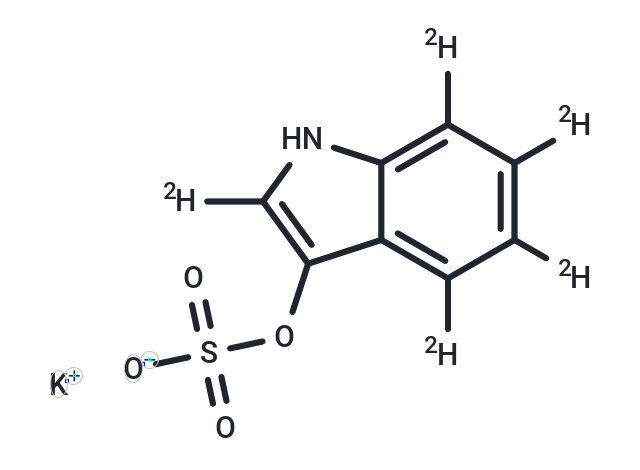 Your shopping cart is currently empty
Your shopping cart is currently empty

Indoxyl sulfate-d5 is intended for use as an internal standard for the quantification of indoxyl sulfate by GC- or LC-MS. Indoxyl sulfate is a uremic toxin and a metabolite of tryptophan. It is formed via sulfation of indole, an intermediate generated from tryptophan by intestinal bacteria, by the sulfotransferase (SULT) isoform 1A1 variant 2 (SULT1A1*2) in the liver. Indoxyl sulfate activates the aryl hydrocarbon receptor (AhR) in HepG2 40/6 hepatoma cells (EC50 = 12.1 nM in a reporter assay). It also inhibits the organic anion transporter (OAT) isoforms OAT1 and OAT3 (Kis = 34.2 and 74.4 µM, respectively for the rat transporters) in S2 proximal tubule cells. Indoxyl sulfate (0.2 and 1 mM) increases superoxide anion and nitric oxide levels in isolated human mononuclear blood cells. It increases serum creatinine and blood urea nitrogen (BUN) levels in the 5/6 nephrectomized rat model of chronic renal failure when administered at a dose of 50 mg/kg.

| Pack Size | Price | USA Warehouse | Global Warehouse | Quantity |
|---|---|---|---|---|
| 25 mg | $1,520 | 6-8 weeks | 6-8 weeks | |
| 50 mg | $1,980 | 6-8 weeks | 6-8 weeks | |
| 100 mg | $2,500 | 6-8 weeks | 6-8 weeks |
| Description | Indoxyl sulfate-d5 is intended for use as an internal standard for the quantification of indoxyl sulfate by GC- or LC-MS. Indoxyl sulfate is a uremic toxin and a metabolite of tryptophan. It is formed via sulfation of indole, an intermediate generated from tryptophan by intestinal bacteria, by the sulfotransferase (SULT) isoform 1A1 variant 2 (SULT1A1*2) in the liver. Indoxyl sulfate activates the aryl hydrocarbon receptor (AhR) in HepG2 40/6 hepatoma cells (EC50 = 12.1 nM in a reporter assay). It also inhibits the organic anion transporter (OAT) isoforms OAT1 and OAT3 (Kis = 34.2 and 74.4 µM, respectively for the rat transporters) in S2 proximal tubule cells. Indoxyl sulfate (0.2 and 1 mM) increases superoxide anion and nitric oxide levels in isolated human mononuclear blood cells. It increases serum creatinine and blood urea nitrogen (BUN) levels in the 5/6 nephrectomized rat model of chronic renal failure when administered at a dose of 50 mg/kg. |
| Molecular Weight | 256.3278 |
| Formula | C8HD5KNO4S |
| Cas No. | 1644451-34-2 |
| Storage | Powder: -20°C for 3 years | In solvent: -80°C for 1 year | Shipping with blue ice/Shipping at ambient temperature. |
| Size | Quantity | Unit Price | Amount | Operation |
|---|

Copyright © 2015-2025 TargetMol Chemicals Inc. All Rights Reserved.